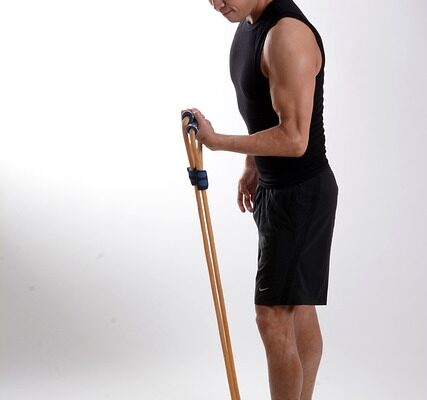Here’s all you need to know about resistance bands, including their benefits and uses.
Resistance bands, in fact, are a fitness craze that experts think deserves a permanent spot in your workout.
If you don’t belong to a gym or other training facility, or if you prefer to work out at home, you might consider adding resistance bands to your arsenal. They can be incorporated into your daily workout routine or used to kick-start an exercise habit directly in your living room or bedroom.
What Exactly Are Resistance Bands?
According to Emily Skye, a certified fitness trainer and inventor of the Emily Skye FIT app, resistance bands are lightweight, affordable, and extremely versatile piece of equipment that allows you to work out anywhere. They can also help you increase strength by creating tension that your muscles have to work against, which makes any exercise very customizable, she explains.
As a result, resistance bands are a wonderful tool for both novices and seasoned gym goers. Assume you are just beginning a workout regimen. In that situation, these bands can assist you in incorporating greater resistance in a regulated manner, applying light pressure to your muscles as your body develops coordination within exercises.

“Say you’re new to strength training and doing bicep curls for the first time,” Skye explains. “With dumbbells, you must use maximal force from the beginning of the exercise to curl up or lift the weight; a resistance band can help you build power by easing you in with less resistance at the beginning of the movement.”
Nevertheless, just like with weights and machines, you can easily raise the resistance of your bands as you get stronger, keeping your muscles challenged. Resistance bands increase muscle stability, mobility, and flexibility, which are all important components of injury prevention.
Resistance bands are also an excellent tool for healing a variety of ailments, according to research. Some studies found resistance band workouts are the most effective way to assist athletes in recovering from knee injuries. Additional studies demonstrate that they are useful in different types of rehabilitation, such as recovering from surgical procedures and regaining walking abilities after a stroke.
Resistance Band Types
Most resistance band workouts include the popular latex or fabric loops (Called tiny bands) that you wrap around your wrists, ankles, or thighs. Yet, there are numerous types of bands available that are better suited for specific types of workouts or movements.
Read below to read the overview of the various types of resistance bands.
- Tube bands with handles: These bands are ideal for any workout that would require the use of a dumbbell, such as bicep curls, shoulder extensions, or shoulder presses.
- Figure 8 bands: These bands can be used in the same way as loop bands; the figure 8 design has soft handle grips that make specific exercises simpler to do.
- Ankle resistance band: This band adds resistance to workouts like side steps and leg lifts by looping around each ankle.
- Power resistance bands: These enormous loops are often more than 40 inches long, making them ideal for bodyweight assistance (such as pull-ups), resistance (such as bear crawls or box leaps), and exercises requiring an anchor point (such as rows).
Therapy bands provide less resistance, allowing for deeper stretches and mobility exercises.
The Advantages of Utilizing Resistance Bands
Resistance bands give a different type of training, which means they have their own set of advantages and disadvantages. Nevertheless, they are just as effective as more expensive technology.
Here are some advantages of using resistance bands.
Strengthens Strength Training
Resistance bands are frequently used to simulate gym equipment such as free weights and cable machines. Resistance bands have been found in studies to produce comparable strength improvements.
According to one study published in the Journal of Strength and Conditioning Research, muscles respond just as effectively to resistance band strength training as they do to other forms of equipment, such as free weights and other machines. The way resistance bands activate your muscles may provide additional benefits over conventional muscle-building approaches.
Increases Mobility
Traditional machines and free weights rely on gravity to produce resistance, making them one-dimensional. Bands, on the other hand, create resistance in all planes, necessitating more muscle activation and more successfully duplicating daily actions.
Improves Coordination
Resistance bands can also help with form and balance. They not only need us to manage motion in an open space, as opposed to machine-based exercises, but they also develop muscular stability and coordination.

Provides a Low-Cost Alternative
Most resistance bands will cost you anywhere from $6 to $30, which is less per month than the average gym subscription. They also leave absolutely little trace, making them convenient to store at home and transport when you’re on the go.
Reduces the risk of injury and is simple to use
According to the National Safety Council, traditional exercise equipment is the source of the majority of sports and recreational injuries in the United States. Because of the way the band strengthens stabilizer muscles and lowers pressure on your joints, a resistance band offers a safer strength-training option.
Resistance bands have a stretch limit, so you’re less likely to overextend muscles or joints. Therefore, you have greater control over the intensity and can halt a workout without regard for gravity.
They’re also easy to utilize. If you’re new to resistance bands, Skye recommends incorporating one into simple bodyweight workouts that you’re already familiar with.
“For example, when doing squats, loop a band right over your knees,” she suggests. “Alternatively, with butterfly kicks, wrap a band around your ankles to give yourself something to kick against—you’ll surely feel the extra work in your core.”
It’s also simple to duplicate basic weighted routines like bicep curls or rows with a long loop band attached under your feet. Nonetheless, an appropriate technique in your exercises is essential, even if it means starting with lower resistance.
How to Pick the Best Resistance Band
Skye believes that you only need one band to get started. Nevertheless, once you learn how adaptable and simple resistance bands are to utilize, you’ll realize you have numerous possibilities. To get started, here’s what the experts recommend.
Purchase a Variety of Resistance Bands
Skye recommends that while shopping for a resistance band, the most important factor to consider is the band’s strength or tension. If you are a newbie, start with a light band. She mentions that bands are frequently color-coded to help you decide, such as yellow for light and black for heavy. But keep in mind that color schemes vary between brands and goods.
Quality should be prioritized When you are choosing Resistance Bands
When making your purchase, you should also seek high-quality bands. Skye advises against using a resistance band that becomes sticky or snaps in the middle of a workout.
“A thicker band is usually more durable,” she explains.
It’s also a good idea to inspect for wear and tear before each workout. Replace it if you see any breaks in the rubber or damage to the band.
Consider the Material
Resistance bands are available in either elastic fabric or rubber latex, with personal choice determining which is ideal.
Skye adds that fabric bands do not roll up or slide around during a workout. As a result, cloth bands are great for lower-body exercises. Latex bands, on the other hand, can provide more stretch, making them ideal for upper body exercises, explosive motions, joint stability exercises, and stretching.

Look at the Accessories
Simple band loops are included in the most basic resistance band kits. But, depending on what you want to use your bands for—or if you want to increase your collection—you can choose bands with different accessories, such as handles, door attachments, or ankle cuffs. If you’re just getting started, keep it simple to foster the development of your workout habit.
To Conclude
Resistance bands are lightweight, adaptable, and simple to use. You may easily save them and use them when you don’t have time to go to the gym. You may even throw them in your bag and use them to work out in the office or when traveling from your hotel room.
They also help to keep your workout program fresh. It’s easy to increase the intensity of your exercise moves to seriously challenge your muscles, but you can also mix it up with flexibility exercises, mobility training, and recuperation movements.
Resistance bands, like all types of exercise, carry inherent dangers. If you’re not sure how and where to begin or how to improve, consult with a licensed personal trainer or physical therapist to help you reach your goals safely.
